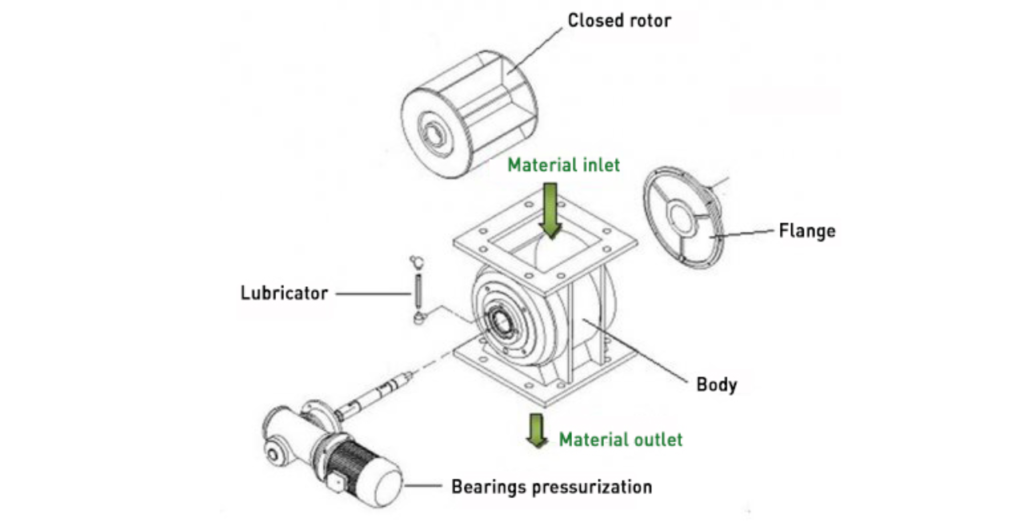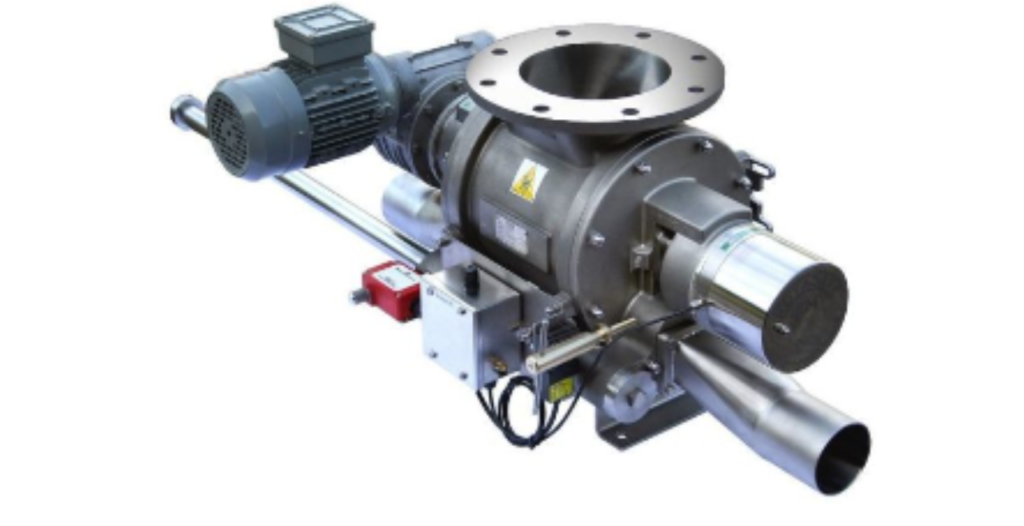Rotary Air Valve (RAL)
Rotary airlock valves, also known as rotary feeders or rotary valves, are essential components in material handling and pneumatic conveying systems. They are used to control the flow of bulk materials while maintaining an airtight seal in systems that involve the transfer of materials from one point to another. Rotary airlock valves come in various types, each designed for specific applications and material characteristics. Here are some common types of rotary airlock valves: |
| Drop-Thru Rotary Valve: Drop-thru rotary valves are the most common type and are suitable for a wide range of bulk materials. They are designed for gravity-fed applications, where materials drop from the inlet into the valve’s rotor pockets and are discharged through the outlet. |
| Blow-Thru Rotary Valve: Blow-thru rotary valves are specifically designed for pneumatic conveying systems. They handle materials in a pressurized system, allowing for a continuous flow of materials without compromising the airlock’s sealing capabilities. |
| Side-Entry Rotary Valve: Side-entry rotary valves are designed for applications where the valve is mounted horizontally or at an angle. They are suitable for applications with limited headroom or space constraints. |
| Sanitary Rotary Valve: Sanitary rotary valves are designed for applications in the food, pharmaceutical, and chemical industries, where hygiene and cleanability are critical. They feature polished surfaces, easy disassembly, and FDA-compliant seals. |
| Metering Rotary Valve: Metering rotary valves are used when precise control of material flow and accurate dosing are required. They often have adjustable rotor vanes or variable speed drives to control the material discharge rate. |
| High-Temperature Rotary Valve: High-temperature rotary valves are designed to handle materials at elevated temperatures, such as hot ash, clinker, or other high-temperature bulk materials encountered in industrial processes. |
| Abrasion-Resistant Rotary Valve: Abrasion-resistant rotary valves are equipped with hardened or coated components to withstand the abrasive nature of certain materials, such as minerals, cement, or aggregates. |
| Spherical Rotary Valve: Spherical rotary valves have a spherical rotor design, which reduces the dead space inside the valve and allows for smoother material flow. They are used in applications where material buildup or contamination is a concern. |
| Close-Clearance Rotary Valve: Close-clearance rotary valves are designed with minimal clearance between the rotor and housing, reducing the risk of material leakage and maintaining a tight seal. They are suitable for fine powders and granular materials. |
| Multi-Vane Rotary Valve: Multi-vane rotary valves have multiple rotor vanes, which help improve sealing efficiency and reduce air leakage in high-pressure or vacuum applications. |
| Quick-Clean Rotary Valve: Quick-clean rotary valves are designed for applications requiring frequent cleaning and product changeovers. They feature easy-access components and quick-disassembly features. |
Double-Flap Rotary Valve: Double-flap rotary valves are designed for applications where large particles or irregularly shaped materials need to pass through. They can handle oversized materials without jamming.
|

| The choice of rotary airlock valve type depends on factors such as the type of material being handled, the application’s operating conditions (pressure, temperature, and flow rate), and specific requirements for sealing, hygiene, or material control. Proper selection and maintenance of rotary airlock valves are crucial for efficient and reliable material handling in various industries. |
| Working Principles: Rotary airlock valves are mechanical devices used to regulate the flow of bulk materials between different areas of a pneumatic conveying or material handling system while maintaining an airtight seal. They work on the principle of a rotating rotor with vanes or blades that traps and releases material as it rotates. The working principles involve the following key aspects: |
| Inlet and Outlet: Rotary airlock valves have an inlet where bulk material enters and an outlet where it exits. The valve’s rotor, located between the inlet and outlet, contains pockets or chambers. |
| Material Intake: As the rotor rotates, the pockets trap and collect bulk material from the inlet. |
| Material Discharge: The rotor continues to rotate, carrying the material within the pockets toward the outlet. As each pocket reaches the outlet, it releases the material into the downstream equipment or process. |
| Sealing: While the material is being transferred, the valve maintains an airtight seal between the inlet and outlet to prevent air leakage and maintain the desired pressure in the system. |
| Advantages: |
| Material Flow Control: Rotary airlock valves provide precise control over the flow of bulk materials, allowing for regulated and continuous material transfer. |
| Airtight Sealing: They maintain an airtight seal between different process areas, preventing air leakage, and ensuring system efficiency. |
| Versatility: Rotary airlock valves are versatile and can handle a wide range of bulk materials, from powders to granules and pellets. |
| Reduced Material Degradation: They minimize material degradation and attrition during transfer, preserving the integrity of the conveyed material. |
| Continuous Operation: Rotary airlock valves can operate continuously, making them suitable for processes that require a constant material flow. |
| Wide Range of Applications: They are used in various industries, including food, pharmaceuticals, chemicals, agriculture, and manufacturing. |
| Disadvantages: |
| Maintenance: Regular maintenance is required to ensure the valve’s proper functioning, including inspection of rotor vanes, seals, and bearings. |
| Material Jamming: Certain materials, such as sticky or abrasive substances, may lead to jamming or wear of the valve components. |
| Material Leakage: In some cases, fine or abrasive materials may cause minimal air and material leakage, reducing overall system efficiency. |

| Applications: |
| Rotary airlock valves find applications in a wide range of industries and processes, including: |
| Pneumatic Conveying Systems: To control the flow of bulk materials in conveying systems. |
| Dust Collection Systems: For discharging collected dust and maintaining system pressure. |
| Mixing and Blending Processes: To introduce ingredients into mixing or blending equipment. |
| Bulk Material Handling: In storage silos, hoppers, and bins to discharge material into downstream equipment. |
| Food and Pharmaceutical Processing: For transferring ingredients, powders, and granules in sanitary applications. |
| Chemical Processing: To regulate the flow of chemicals and powders in chemical manufacturing. |
| Agriculture: In grain handling and feed processing equipment. |
| Minerals and Mining: For handling and transporting ores and minerals. |
| MOC : |
| The Material of Construction (MOC) for a rotary airlock valve (RAL) can vary depending on several factors, including the type of material being handled, the operating conditions, and any specific requirements for the application. Here are some common materials of construction for rotary airlock valves: |
| Carbon Steel: Carbon steel is a widely used material for rotary airlock valves. It is suitable for handling many bulk materials and provides good strength and durability. However, it may not be suitable for highly corrosive or abrasive materials. |
| Stainless Steel: Stainless steel, particularly types like 304 and 316, is often chosen for its corrosion resistance. It is suitable for applications involving food, pharmaceuticals, and chemicals. Higher-grade stainless steel may be used for more corrosive environments. |
| Cast Iron: Cast iron is a robust material used for handling abrasive materials such as sand, minerals, and cement. It offers good wear resistance but may not be suitable for applications requiring corrosion resistance. |
| Aluminum: Aluminum is a lightweight material used in applications where weight is a concern. It is suitable for handling non-abrasive materials and is often chosen for industries like plastics processing. |
| Specialty Alloys: For specific applications with extreme conditions, specialty alloys such as Hastelloy or Inconel may be used to provide resistance to highly corrosive environments or high-temperature materials. |
| Ceramics and Coatings: In cases where abrasion resistance is critical, ceramic liners or coatings can be applied to the valve’s interior surfaces to protect against wear. |
| Summary: |
| Rotary airlock valves are essential components in material handling and pneumatic conveying systems. They work on the principle of a rotating rotor with pockets that trap and release bulk materials while maintaining an airtight seal. These valves provide precise material flow control, ensure airtight sealing, and are versatile for various industries and applications. While they offer many advantages, regular maintenance is required to prevent issues like material jamming and leakage. Proper selection and maintenance of rotary airlock valves are crucial for efficient and reliable material handling processes. |


 Sales & Marketing:
Sales & Marketing:  Service Supports:
Service Supports:  Website:
Website: 